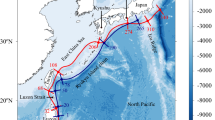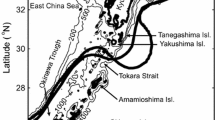Abstract
The response of a jet to sudden winds was examined using a simple numerical regional model and an analytical model to investigate the mechanism underlying the local wind dynamics of seasonal velocity variations in the upper layer of the Kuroshio. The numerical model was used to simulate the distinct seasonal features in summer and autumn in the East China Sea and successfully reproduced the seasonal features in the velocity field under different sudden wind conditions. The current speed increased and decreased under summer and autumn wind conditions, respectively; and the current axis shifted to the offshore and inshore sides under summer and autumn wind conditions, respectively. We focused on the current speed variation and hypothesized that the current speed variation is forced by the thermocline variation due to nonlinear Ekman pumping. This hypothesis was examined using a rigid-lid reduced-gravity analytical model with Ekman layer dynamics. The analytical model results showed that the asymmetry of the jet profile has a marked effect on the current speed variation. With a higher wavenumber on the west side of a northward jet, the current speed increased and decreased under summer and autumn wind conditions, respectively. These findings can be used to explain the seasonal velocity variations in the upper layer in the East China Sea and over the entire Kuroshio path.











Similar content being viewed by others
References
Blumberg AF, Mellor GL (1987) A description of a three-dimensional coastal ocean circulation model. Three Dimens Coast Ocean Models 4:1–16
Large WG, Pond S (1981) Open ocean momentum flux measurements in moderate to strong winds. J Phys Oceanogr 11(3):324–336
Liu ZJ, Nakamura H, Zhu XH, Nishina A, Guo X, Dong M (2019) Tempo-spatial variations of the Kuroshio current in the Tokara Strait based on long-term ferryboat ADCP data. J Geophys Res Oceans 124(8):6030–6049
Ichikawa H, Beardsley RC (1993) Temporal and spatial variability of volume transport of the Kuroshio in the East China Sea. Deep Sea Res Part I 40(3):583−605
Nakamura H (2020) Changing Kuroshio and its affected shelf sea: a physical view. In: Chen CT, Guo X (eds) Changing Asia-Pacific marginal seas. Atmosphere, earth, ocean & space. Springer, Singapore
Nakamura H, Nonaka M, Sasaki H (2010) Seasonality of the Kuroshio path destabilization phenomenon in the Okinawa Trough: a numerical study of its mechanism. J Phys Oceanogr 40(3):530–550
Nakamura H, Hiranaka R, Ambe D, Saito T (2015) Local wind effect on the Kuroshio path state off the southeastern coast of Kyushu. J Oceanogr 5(71):575–596
Niiler PP (1969) On the Ekman divergence in an oceanic jet. J Geophys Res 74(28):7048–7052
Oey LY, Hsin YC, Wu CR (2010) Why does the Kuroshio northeast of Taiwan shift shelfward in winter? Ocean Dyn 60:413–426
Rossby T, Zhang HM (2001) The near-surface velocity and potential vorticity structure of the Gulf Stream. J Mar Res 59(6):949–975
Tsujino H, Nishikawa S, Sakamoto K, Usui N, Nakano H, Yamanaka G (2013) Effects of large-scale wind on the Kuroshio path south of Japan in a 60-year historical OGCM simulation. Clim Dyn 41:2287–2318
Wu CR, Hsin YC, Chiang TL, Lin YF, Tsui IF (2014) Seasonal and interannual changes of the Kuroshio intrusion onto the East China Sea Shelf. J Geophys Res-Oceans 119:5039–5051
Xue H, Mellor G (1993) Instability of the Gulf Stream front in the South Atlantic Bight. J Phys Oceanogr 23(11):2326–2350
Zhai X, Greatbatch RJ (2007) Wind work in a model of the northwest Atlantic Ocean. Geophys Res Lett 34:L04606
Zhang ZL, Nakamura H, Zhu XH (2021) Seasonal velocity variations over the entire Kuroshio path part I: data analysis and numerical experiments. J Oceanogr. https://doi.org/10.1007/s10872-021-00604-7
Acknowledgements
We thank the handling editor and anonymous reviewers for their important comments and suggestions. This study was supported by the Japan Society for the Promotion of Science (JSPS) (KAKENHI Grant Numbers 15H03725, 15H05821, and 20H05169), the Natural Science Foundation of China (41920104006, and 41776107), and the Scientific Research Fund of the Second Institute of Oceanography, MNR (JZ2001).
Author information
Authors and Affiliations
Corresponding author
Appendix
Appendix
1.1 Current axis variation
Although we focused on the current speed variation in this study, the current path variation is also an important seasonal characteristic in the velocity field (Sect. 3.1). To quantitatively evaluate the current path variation, we define the current path variation as the horizontal shift of the current axis, which is defined as the location of the maximum v-component velocity within the width of the jet. According to this definition, the current axis near the sea surface shifts an average of approximately 10-km eastward and westward in summer and autumn, respectively, over the meridional length of the model domain [relative to the initial state (Fig. 5)]. Figure 12 shows the vertical section of the v-component velocity under summer and winter wind conditions on day 100; the values are meridionally averaged over the area from 200 to 800 km. Current axis variations occur near the sea surface and at greater depths in the jet. The shift of the current axis is the direction of Ekman transport; thus, the current axis shifts eastward (westward) when a northward (southward) wind is present. However, such a current axis variation can barely be explained by the classical Ekman theory, because Ekman transport only explains variations within the Ekman layer (0–10 m). Further, the comparison between the vertical section of the density anomalies (Fig. 6) and that of the w anomalies (Fig. 7) indicates that thermocline variations are forced by nonlinear Ekman pumping. Next, we investigate the response of the current axis position to nonlinear Ekman pumping based on the analytical solution shown in Sect. 4.1.
Unlike the current speed variation, the occurrence of the current axis variation does not require an asymmetrical jet profile. According to Eq. (28), the current axis variation can be explained in terms of the velocity variation over the width of the jet; for the case of \(B > 0\) (i.e., the summer wind condition), Eq. (28) gives positive and negative values on the eastern and western sides of the jet, respectively (Fig. 13), indicating an eastward shift of the Kuroshio current axis in summer. Conversely, the result is the opposite for \(B < 0\) (i.e., the autumn wind case). These results are consistent with the model outputs shown in Fig. 5. Next, we check whether the analytical model could quantitatively reproduce the current axis variation [i.e., a 10-km westward (eastward) shift in the current axis under summer (autumn) wind conditions]. By combining the background values [vb, Eq. (23)] and deviation [vd, Eq. (28)] velocity components, the velocity profile of the jet after the current axis shift is
which can be rewritten as follows:
where
Equations (41) and (42) can be estimated using the given values: g′ is assumed to be 0.02 m s−2, H is 200 m, f is \(7.29 \times 10^{ - 5}\), BAk2 ~ C is \(2 \times 10^{ - 5}\) m s−1 (Fig. 8), t is \(1.73 \times 10^{6}\) s (20 days), and k is \(5.1 \times 10^{ - 5}\). The second term in Eq. (41) is approximately 0.02, which is approximately 50 times smaller than A (~ 100). Here, k was estimated using the jet velocity profile on day 50. Therefore, D \(\approx\) A, and Eq. (40) becomes
Equation (43) indicates that the shape of the jet is almost unchanged, except that the current axis shifts by \(\phi /k\) eastward (westward) in summer (autumn). \(\phi /k\) increases with t but has a limit of \({\uppi }\)/2 k, which is approximately 30 km. This value is of the same order as the current axis variation (10 km). Therefore, the analytical model also explains the amount of the current axis variation. However, current axis shifts of over 30 km take more than 3 years; this is longer than the simulated result, probably because of the simple sinusoidal jet profile.
1.2 Nonlinear Ekman pumping velocity
The derivation of the nonlinear Ekman pumping formula, represented by Eq. (12), is explained briefly in this section. The rigorous derivation of Eq. (12) was reported by Nakamura et al. (2010, 2015). Readers may refer to their papers for further details. The basic equations are the same as those in Eqs. (9–10), as reported by Nakamura et al. (2010). Here, we consider an f-plane ocean configured for the same domain used in Sect. 2: the x and y coordinates are the distances in the zonal and meridional directions, respectively; the modeled ocean is independent of y and has a y-independent northward geostrophic flow and a northward wind stress: ug(x, y) = 0, vg(x, y) = vg(x), τx(x, y) = 0, and τy(x, y) = constant. The basic equations then become
where (ue, ve) is the vertically averaged ageostrophic Ekman transport, ρ0 is the density of sea water, f is the Coriolis parameter, d is the Ekman layer thickness that is assumed to be uniform, and we is the Ekman pumping velocity at the bottom of the Ekman layer. Since τx = 0, we obtain
where f* is the effective Coriolis parameter (Niiler 1969):
Equation (47) is a nonlinear formula, which we call the nonlinear Ekman pumping velocity in this study. With the assumption \(f \gg \frac{{\partial v_{{\text{g}}} }}{\partial x}\), Nakamura et al. (2015) linearized Eq. (47) as follows:
where \(\left( {\tau_{x}^{0} , \tau_{y}^{0} } \right)\) and \(\left( {\tau_{x}^{1} , \tau_{y}^{1} } \right)\) are the uniform and space-dependent components of the wind stress \(\left( {\tau_{x} , \tau_{y} } \right)\), respectively. The first term in Eq. (49) is the Ekman pumping resulting from local wind stress curl. The second term is the Ekman pumping owing to the effective Coriolis parameter. Since only the northward and southward uniform wind stresses were used in the numerical model, we neglected the first term and only discussed the effect of the second term. Equation (49) then becomes the same as in Eq. (12).
Rights and permissions
About this article
Cite this article
Zhang, ZL., Nakamura, H. & Zhu, XH. Seasonal velocity variations over the entire Kuroshio path part II: dynamical interpretation for the current speed variation. J Oceanogr 77, 745–761 (2021). https://doi.org/10.1007/s10872-021-00603-8
Received:
Revised:
Accepted:
Published:
Issue Date:
DOI: https://doi.org/10.1007/s10872-021-00603-8






